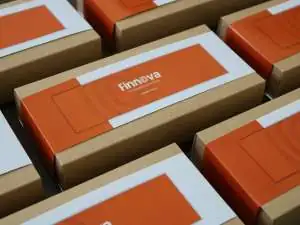In this steep competitive era, every business needs promotional materials (banner, brochure, flyer, visiting card, office stationery, etc.) to allure the customers and to establish their presence strongly in the market. Though an impeccable design can make your promotional material more attractive and eye-catching, still, if you want them to stand out from the dunces, you should choose wisely the right print finishing techniques that are available in the market.
Print finishing refers to any process that is applied to the materials once they have got printed. Though print finishing may seem like a small part of the entire printing process itself, still, it can make a striking difference to any printed materials. That’s why many digital printing and packaging machine companies in India give stress on print finishing techniques to make their product more attractive and convincing. In this article, we are going to discuss various types of print finishing techniques that are available in the market. But before that, let’s take a look at different types of printing techniques that are widely available in the print industry.
![]()
1.Offset Printing: This type of printing technology uses plates (made of aluminum) to transfer an image onto a rubber blanket. Then, it rolls that image onto a sheet of paper. This is called offset because here ink is not directly transferred to the sheet. This type of printing is ideal when larger quantities are needed.
2.Digital Printing: Like offset printing, this type of printing doesn’t use plates rather it uses a toner or larger printers which do use liquid ink. Digital printing is ideal when lower quantities are required. Digital printing equipment is less expensive as compared to offset printing equipment. Moreover, the setup cost is also much lower for digital printing for short runs.
If you are thinking digital printing vs offset printing which one should be ideal for your promotional campaign, always consider the quantity that you need to run your campaign. If you need only 100 flyers or 50 brochures, then digital printing will give you immense benefit in this regard. Offset printing is good only if the quantity is higher.
Print Finishing Techniques
![]()
Now, let’s unravel some of the important print finishing techniques so that you can make more effective and eye-catching printed materials which will accelerate the growth of your business by attracting more customers.
1. Cutting and Creasing:
Sometimes, printed materials need to be cut and creased after printing so that they can be folded easily. A die cutter is the most common cutting machine that is used to cut printed materials. The die supports the material that is being cut and has a hole into which a punch (made of cutting blades) fits properly. The work which needs to be cut is fitted into the machine and the punch lowered down to cut. The same technique with blunt blades is applied for creasing.
2. Lamination:
Lamination is the most common finish which has got huge appreciation due to its professional look and high-quality. Lamination adds a protective coating layer to the printed surface and also improves sturdiness and water resistance. Lamination can be either glossy or matte, but it improves the tactile feel of the printed surface. A high gloss lamination improves the sharpness and appearance of the printed materials. Though matte laminated prints are quite subdued, still, they add an elegant and luxurious finish to the printed surface. Lamination is used when you need sturdiness of your products. That’s why lamination is ideal for business cards and soft covered books.
3. Varnishing:
Though varnishes are associated with wood, still, they are used for papers. Varnishes can be either matte or glossy depending on your requirements. Varnishes are ideal for magazine covers, magazine pages, brochures, etc. Let’s take a look at different types of varnishing.
![]()
Gloss Varnishing:
This type of varnishing is used to improve the appearance of printed photographs or images in brochures or flyers. The coated layer reflects the light and thus, it makes the color more prominent, bright, and vivid. You can use gloss varnishing in sales or promotional materials where the pictures play an imperative role in your marketing.
Matte Varnish:
This type of varnishing gives a smooth and non-glossy look to the printed surface. This varnishing softens the appearance of printed photographs or images. You can easily read a small text in a booklet or a leaflet if the printed surface is coating with matte varnish.
Silk Varnishing:
This type of varnishing represents the middle ground between the above two varnishing methods. Here, your finished product neither looks too glossy not look to subtle as matte varnishing.
Machine Sealing:
Machine sealing is an invisible coating that is applied to a printed material by a printer. Though it doesn’t make any difference to the appearance of the printed item, still, it seals the ink under a protective coat. This is applied to the first turnaround materials like leaflets.
UV Varnishing:
In this type of varnishing, the ultraviolet technique is applied to produce a transparent finish to your printed materials. With the help of UV lighting, the coating is dried. This type of varnish makes colors more attractive and vivid and also, provides a smooth and glossy layer to your printed material.
All Over UV Varnish:
In this type of varnishing, a UV seal is applied all over the printed surface. A gloss UV varnish is the most common type of all-over UV varnishing. Sometimes, silk and matte varnish are also available with all over UV varnish.
A gloss UV varnish is the most common type of all-over UV varnishing. Sometimes, silk and matte varnish are also available with all over UV varnish.
Spot UV Varnish:
As per the name, in this type of varnishing, a spot UV varnish is applied in the selected or particular areas or spots. This type of varnishing highlights some parts of the printing and draws user attention to that particular part of the design. This type of varnishing creates a lot of interest in the mind of the users. You can use this type if varnishing if you want to create an astounding impression on your presentation folder or brochure cover.
Textured Spot UV Varnish:
In this type of varnishing, a designer not only mixes the textures on the same printed surface but also, he tries to reinforce the tactile properties of the product which he is planning to depict. Now, for example, an ornamental glassware manufacturer can use a raised effect gloss UV varnish to give a highly reflective and 3-dimensional effect of a piece of glasswork.
4. Foil Stamping:
![]()
In this type of finishing, a malleable metallic material(foil) is applied to the print surface with the help of heat and pressure. Foils are not only limited to gold and silver but also you can use other varieties like pigmented, holographic and security foils. This type of finishing makes your printed products more decorative and adds a little bit of luxury to your project. Foil stamping is usually done in combination with embossing. In this method, pressure and heat are applied to the foil and the end products look like much shinier and glossier than normal metallic inks. But this method is quite expensive as special tools are required to be made for the process. Foil stamping is mainly used to highlight or emphasize the logo or name of the company.
5. Embossing:
Embossing is a type of finishing where you need to raise some parts of the printed page for emphasis and texture. By using embossing, you can enhance your print with amazing 3-d effects. Embossing is generally applied in conjunction with other techniques like foil stamping or spot UV lamination. Embossing adds a tactile dimension to your printed material. Now, your clients can feel all the images and texts properly. So, in a nutshell, embossing is the stamping of a design into a paper or card. This design produces a raised effect on the material.
6. Letterpress or Debossing:
This is one of the traditional printing techniques that are available in the market. Some printers often call it debossing. This is just the opposite of embossing. This technique usually applied to depress or indent certain portion of things of a page. Earlier, this technique is used for texts, but now, it is applied for pressing logos and other design elements.
7. Thermography:
![]()
Thermography takes your printed items to the next level by producing a raised finish to the selected areas (logo, texts, etc.). This is a less expensive technique that highlights some parts of your printed items. You can use thermography techniques in your corporate stationaries, packaging, folder cover, report cover, and in invitations. Different thermographic powder gives different finishes to your printed items.
- Metallic powder gives a metallic sheen to your products
- Glitter powder gives a sparkling and dazzling effect to your products
- The fluorescent powder makes the colored finish brighter and vivid
Hope, this article gave you adequate information and knowledge about various print finishing techniques that are available in the market. A print finishing is the best way which can make your product from good to great. But print finishing is not a cheap thing, you need a certain budget before plunging into this. If you want an amazing result, then you should wisely decide what type of technique you need to use on a certain project.
Source: CGSASP
Custom Your Own Book, Packaging Boxes, Board Game and more
Our Social Media: Facebook


